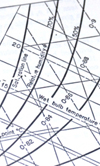Humidity - forget it?
 In my younger days, when fuel injection was but a luxury and the roads were less crowded, the journey to work was always so much more enjoyable in the foggy early morning light than at any other time. The engine in my transport - a high-compression 'A' series unit, tuned ever so close to (and sometimes beyond!) combustion 'knock' - would run totally free of detonation and be a joy to drive around the twisting country roads where I lived.
In my younger days, when fuel injection was but a luxury and the roads were less crowded, the journey to work was always so much more enjoyable in the foggy early morning light than at any other time. The engine in my transport - a high-compression 'A' series unit, tuned ever so close to (and sometimes beyond!) combustion 'knock' - would run totally free of detonation and be a joy to drive around the twisting country roads where I lived.
As a development engineer I put this down to the water vapour in the air suppressing power-sapping 'knock' because at no other times during the winter was the carburettored car anywhere near as responsive and rewarding to drive. And that was most probably the case. But the effect of water vapour in the atmosphere can have a significant effect on the performance of an engine in other ways.
An engine on the dynamometer will generally be tested under controlled conditions. Even if the facility cannot manipulate the barometric pressure, temperature and humidity of the incoming air it will generally be within a narrow range.
When an engine is calibrated, therefore, it has been done so under a restricted range of conditions. When it goes out into the big wide world, however, it can experience extremes of temperature and humidity that can have a significant effect on its performance.
In a fuel-injected unit, much of this variation can be compensated for in the target air:fuel ratio, and changes in the air density will automatically be offset by the engine controller. But for an engine equipped with carburettors the situation is very different.
As well as the changes to the ambient air temperature and day-to-day variations in atmospheric pressure, the amount of water vapour in the air displacing the air itself also has to be considered. In the cold (4 C) dry air of a desert region the vapour pressure displacing this air can be very little, something like 5 mm of Hg at 20% humidity. Along the road at the coast and later in the day, when the temperature has risen to 34 C and an energy-sapping 90% relative humidity, that partial pressure will now be nearer 36 mm of Hg.
The difference in the air consumed could therefore change by as much as 4% as a result of changes in humidity alone. Coupled with the drop in density due to the temperature, this will have a major effect on the jetting of a carburettor tuned to lesser extremes.
Unfortunately there is no easy solution to this dilemma. But armed with the test conditions of pressure, temperature and humidity on the dyno - which I'm sure you've all kept somewhere - the relative change in air density can be calculated.
Because of the way a carburettor works, a 10% change in relative density may not require a 10% reduction in main jet size - something like 3-4% might be nearer the truth. But what it will tell you is which way to go (either up or down) in terms of jet size to return to maximum performance. The rest is down to you, and the copious notes you will endeavour to keep thereafter.
At the end of it all, however, you will look rather enviously at those with fuel injection.
Fig. 1 - Hygrometric chart
Written by John Coxon